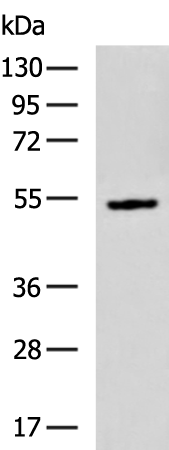
| WB | 咨询技术 | Human,Mouse,Rat |
| IF | 咨询技术 | Human,Mouse,Rat |
| IHC | 咨询技术 | Human,Mouse,Rat |
| ICC | 技术咨询 | Human,Mouse,Rat |
| FCM | 咨询技术 | Human,Mouse,Rat |
| Elisa | 1/5000-1/10000 | Human,Mouse,Rat |
| Aliases | E16; CD98; LAT1; 4F2LC; MPE16; D16S469E |
| WB Predicted band size | 55 kDa |
| Host/Isotype | Rabbit IgG |
| Antibody Type | Primary antibody |
| Storage | Store at 4°C short term. Aliquot and store at -20°C long term. Avoid freeze/thaw cycles. |
| Species Reactivity | Human, Mouse |
| Immunogen | Synthetic peptide of human SLC7A5 |
| Formulation | Purified antibody in PBS with 0.05% sodium azide and 50% glycerol. |
+ +
1. **"SLC7A5 regulates macrophage polarization and immune responses through modulating arginine metabolism"**
*作者:Li, X., et al.*
摘要:研究通过SLC7A5抗体阻断实验,揭示SLC7A5通过调控巨噬细胞精氨酸代谢影响M1/M2极化,进而调节炎症反应及肿瘤微环境。
2. **"Targeting SLC7A5 with a novel antibody-drug conjugate for cancer therapy"**
*作者:Smith, J., et al.*
摘要:开发针对SLC7A5的抗体偶联药物(ADC),利用抗体特异性靶向高表达SLC7A5的肿瘤细胞,体内实验显示显著抑制异种移植瘤生长。
3. **"SLC7A5 expression in glioblastoma: Correlation with patient prognosis and therapeutic targeting"**
*作者:Wang, Y., et al.*
摘要:通过免疫组化(使用SLC7A5抗体)分析胶质母细胞瘤样本,发现SLC7A5高表达与患者生存期缩短相关,体外实验证实抑制SLC7A5可增强化疗敏感性。
4. **"Functional characterization of SLC7A5 in T cell activation using CRISPR and antibody-based approaches"**
*作者:Garcia, M., et al.*
摘要:结合CRISPR敲除和SLC7A5抗体阻断,揭示该转运蛋白在T细胞活化中调控亮氨酸摄取及mTOR通路激活的关键作用。
The SLC7A5 antibody is a research tool designed to detect and study the solute carrier family 7 member 5 (SLC7A5), a transmembrane protein also known as LAT1 (L-type amino acid transporter 1). SLC7A5 forms a heterodimer with SLC3A2 (CD98hc) to function as a bidirectional transporter of large neutral amino acids, such as leucine, across cell membranes. It plays a critical role in nutrient uptake, cellular metabolism, and mTOR signaling, making it essential for cell growth and proliferation.
SLC7A5 is highly expressed in rapidly dividing cells, including cancer cells and activated immune cells, where it supports elevated metabolic demands. Its overexpression in tumors correlates with poor prognosis, highlighting its potential as a therapeutic target. The antibody is widely used in techniques like Western blotting, immunohistochemistry (IHC), and immunofluorescence (IF) to investigate SLC7A5 expression patterns, subcellular localization, and regulatory mechanisms in both physiological and pathological contexts.
In cancer research, SLC7A5 antibodies help elucidate its role in tumor progression, drug resistance, and immune microenvironment modulation. Additionally, studies explore its involvement in neurological disorders and autoimmune diseases. Validated antibodies are crucial for distinguishing SLC7A5 from related transporters and ensuring specificity in experimental models, aiding the development of targeted therapies.
×